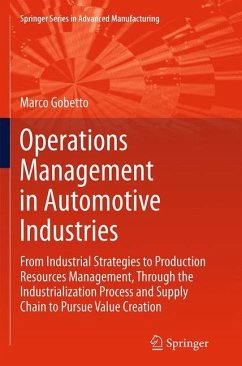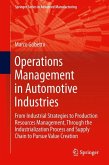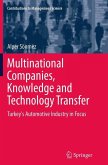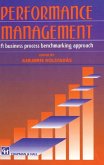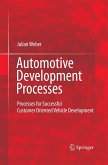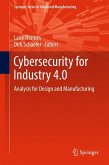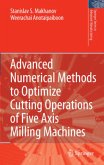Marco Gobetto
Operations Management in Automotive Industries
From Industrial Strategies to Production Resources Management, Through the Industrialization Process and Supply Chain to Pursue Value Creation
Marco Gobetto
Operations Management in Automotive Industries
From Industrial Strategies to Production Resources Management, Through the Industrialization Process and Supply Chain to Pursue Value Creation
- Broschiertes Buch
- Merkliste
- Auf die Merkliste
- Bewerten Bewerten
- Teilen
- Produkt teilen
- Produkterinnerung
- Produkterinnerung
This book has proved its worth over the years as a text for courses in Production Management at the Faculty of Automotive Engineering in Turin, Italy, but deserves a wider audience as it presents a compendium of basics on Industrial Management, since it covers all major topics required. It treats all subjects from product development and "make or buy"-decision strategies to the manufacturing systems setting and management through analysis of the main resources needed in production and finally exploring the supply chain management and the procurement techniques. The very last chapter…mehr
Andere Kunden interessierten sich auch für
![Operations Management in Automotive Industries Operations Management in Automotive Industries]() Marco GobettoOperations Management in Automotive Industries89,99 €
Marco GobettoOperations Management in Automotive Industries89,99 €![Multinational Companies, Knowledge and Technology Transfer Multinational Companies, Knowledge and Technology Transfer]() Alper SönmezMultinational Companies, Knowledge and Technology Transfer81,99 €
Alper SönmezMultinational Companies, Knowledge and Technology Transfer81,99 €![My Cognitive autoMOBILE Life My Cognitive autoMOBILE Life]() Sebastian WedeniwskiMy Cognitive autoMOBILE Life37,99 €
Sebastian WedeniwskiMy Cognitive autoMOBILE Life37,99 €![Performance Management Performance Management]() Performance Management42,99 €
Performance Management42,99 €![Automotive Development Processes Automotive Development Processes]() Julian WeberAutomotive Development Processes105,99 €
Julian WeberAutomotive Development Processes105,99 €![Cybersecurity for Industry 4.0 Cybersecurity for Industry 4.0]() Cybersecurity for Industry 4.0129,99 €
Cybersecurity for Industry 4.0129,99 €![Advanced Numerical Methods to Optimize Cutting Operations of Five Axis Milling Machines Advanced Numerical Methods to Optimize Cutting Operations of Five Axis Milling Machines]() Stanislav S. MakhanovAdvanced Numerical Methods to Optimize Cutting Operations of Five Axis Milling Machines81,99 €
Stanislav S. MakhanovAdvanced Numerical Methods to Optimize Cutting Operations of Five Axis Milling Machines81,99 €-
-
-
This book has proved its worth over the years as a text for courses in Production Management at the Faculty of Automotive Engineering in Turin, Italy, but deserves a wider audience as it presents a compendium of basics on Industrial Management, since it covers all major topics required. It treats all subjects from product development and "make or buy"-decision strategies to the manufacturing systems setting and management through analysis of the main resources needed in production and finally exploring the supply chain management and the procurement techniques. The very last chapter recapitulates the previous ones by analysing key management indicators to pursue the value creation that is the real purpose of every industrial enterprise. As an appendix, a specific chapter is dedicated to the basics of production management where all main relevant definitions, techniques and criteria are treated, including some numerical examples, in order to provide an adequate foundation for understanding the other chapters. This book will be of use not only to Automotive Engineering students but a wide range of readers who wish to gain insight in the world of automotive engineering and the automotive industry in general.
Produktdetails
- Produktdetails
- Springer Series in Advanced Manufacturing
- Verlag: Springer / Springer Netherlands
- Artikelnr. des Verlages: 978-94-024-0139-4
- Softcover reprint of the original 1st ed. 2014
- Seitenzahl: 268
- Erscheinungstermin: 23. August 2016
- Englisch
- Abmessung: 235mm x 155mm x 15mm
- Gewicht: 430g
- ISBN-13: 9789402401394
- ISBN-10: 9402401393
- Artikelnr.: 45588109
- Herstellerkennzeichnung
- Books on Demand GmbH
- In de Tarpen 42
- 22848 Norderstedt
- info@bod.de
- 040 53433511
- Springer Series in Advanced Manufacturing
- Verlag: Springer / Springer Netherlands
- Artikelnr. des Verlages: 978-94-024-0139-4
- Softcover reprint of the original 1st ed. 2014
- Seitenzahl: 268
- Erscheinungstermin: 23. August 2016
- Englisch
- Abmessung: 235mm x 155mm x 15mm
- Gewicht: 430g
- ISBN-13: 9789402401394
- ISBN-10: 9402401393
- Artikelnr.: 45588109
- Herstellerkennzeichnung
- Books on Demand GmbH
- In de Tarpen 42
- 22848 Norderstedt
- info@bod.de
- 040 53433511
Marco Gobetto was born in Rimini (RN, Italy) in 1967 and took his master's degree in Electronic Engineering in 1993 at Politecnico of Turin. He currently holds positions as Manufacturing Training Unit Manager at FIAT Sepin S.c.p.A. and Professor at the Faculty of Automotive Engineering. He has taught courses in both Production Management and Production Processes, Safety, Organization and Management. After having complete his University studies, he began his professional career at FIAT Auto S.p.A. in the Manufacturing Engineering Department, as part of the Style Design Manufacturing Analysis Team. From there he proceeded to the position of Body in White Process Engineer, contributing to the production launches of two new cars in Italy and then coordinating industrialization activities in Poland for a new body in white model. In 1998 he moved to Ferrari S.p.A. as Body in White Plant Manager at the "Carrozzeria Scaglietti" facility in Modena. In 2000 he left FIAT to assume responsibility for the Manufacturing Engineering Department at Carrozzeria Bertone S.p.A. in Grugliasco (TO,, Italy). {AU: PLEASE CONFIRM "TO,," IT IS OK, IT STANDS FOR "TORINO PREFECTURE" } In two years, three new models of vehicles were launched and, for the first time in Bertone history, second and third shifts in production were activated. At the beginning of 2002 he rejoined the FIAT Group at ISVOR FIAT S.c.p.A. where he specialized in Total Productive Maintenance and Continuous Improvement training programs, following on IVECO and FIAT Powertrain sectors. He subsequently coordinated international training initiatives for a joint venture in India between FIAT and TATA. In 2007 he assumed responsibility for the Manufacturing, Quality and Product Development Training Area that, at the end of 2008, became the central Manufacturing Training Unit in the new training organization in FIAT, thereby contributing to all initiativesworldwide both in FIAT and Chrysler LLC with a major focus on World Class Manufacturing, the Corporate Production System.
Foreword.- About the author.- Introduction.- Acknowledgements.- 1 Historical Outlines and Industrial Strategies for Automotive Industries.- 1.1 Historical Outlines in Automotive Industries.- 1.2 Strategic Planning of Production Activities.- 1.3 Process Integration and "Make or Buy" Decision Making.- 1.4 Manufacturing Systems' Set-Up and Location Criteria.- 1.5 Technologies for Materials Applied to Vehicles' Construction Overview.- 1.6 Sketches for Manufacturing Systems Adopted in Cars Manufacturing.- 1.7 Systems' Strategical Prerogatives.- 2 From project to product.- 2.1 Standardization Logics and Project Setting Up.- 2.2 Industrialization Process Description.- 2.3 Product/Process Information Technology System.- 2.4 Product Composition Analysis.- 2.5 Product Technical Changes Management.- 3 Manufacturing Engineering and Equipment Efficiency Evaluation.- 3.1 Manufacturing Engineering Planning and Executive Project.- 3.2 Production Capacity Setting.- 3.3 Working Time Analysis Methodologies.- 3.4 Man/Machine Interaction and Standard Working Time Defining.- 3.5 Equipment Times Deployment Diagram.- 3.6 Integrated Production System Introduction.- 3.7 Operative Productivity and Flexibility.- 3.8 Equipment and Machine Loading.- 3.9 Installed Productive Capacity Defining.- 4 Work Analysis and Labour Productivity Evaluation Criteria.- 4.1 Activity Level and Labour Efficiency.- 4.2 Manpower Planning.- 4.3 Working Time Length and Flexibility.- 4.4 Labour Productivity and Improvement Plans.- 4.5 Input Data for Operative Control.- 4.6 Tasks Assignment and Workload Balancing.- 4.7 Production Employees Motivation and Rewarding.- 5 Manufacturing System Management and Maintenance Criteria.- 5.1 Plant Manufacturing System.- 5.2 Equipment Reliability and Maintainability.- 5.3 Maintenance Management.- 5.4 Costs and Maintenance Effectiveness Correlation.- 5.5 General and Complementary Equipment for Production.- 5.6 Tools andConsumables Management.- 5.7 "Total Productive Maintenance" approach.- 6 Logistics and Supply Chain Basics for Automotive Application.- 6.1 Logistics Historical Evolution and Actual Strategies.- 6.2 Logistics Flows in the Supply Chain.- 6.3 Material Handling and Inventory Management Methodologies.- 6.4 Production and Delivery Planning.- 6.5 Logistics Information Technology Systems.- 6.6 Logistics Key Performance Indicators.- 7 Global Purchasing Operations.- 7.1 Purchasing Department's Role.- 7.2 Purchasing Policies Evolution.- 7.3 Purchasing Marketing and Global Sourcing Policies.- 7.4 Suppliers Network Management.- 7.5 Order Procedure and Cooperation Agreements.- 7.6 Supplying Cost and Purchasing Effectiveness Indicators.- 7.7. "E-Procurement" Techniques.- 8 Quality Management and Continuous Improvement.- 8.1 The "Learning Curve" Concept.- 8.2 Production Ramp Up and Maximum Rate Achievement.- 8.3 Quality Management in Industrial Processes.- 8.4 Quality and Reliability Assurance Techniques in Product Design Phase.- 8.5 "Total Quality Management" and Continuous Improvement Approach.- 9 Value Creation and Final Considerations.- 10 (APPENDIX) Production Management Basics.- 10.1 The Product.- 10.2 Production Systems.- 10.3 Criteria for the Stock and Lots Management.- 10.4 Problems Connected to the Planning Horizon.- 10.5 APP (Aggregated Production Planning).- 10.6 MPS (Master Production Schedule).- 10.7 MRP (Material Requirement Planning).- List of Abbreviations.
Foreword.- About the author.- Introduction.- Acknowledgements.- 1 Historical Outlines and Industrial Strategies for Automotive Industries.- 1.1 Historical Outlines in Automotive Industries.- 1.2 Strategic Planning of Production Activities.- 1.3 Process Integration and "Make or Buy" Decision Making.- 1.4 Manufacturing Systems' Set-Up and Location Criteria.- 1.5 Technologies for Materials Applied to Vehicles' Construction Overview.- 1.6 Sketches for Manufacturing Systems Adopted in Cars Manufacturing.- 1.7 Systems' Strategical Prerogatives.- 2 From project to product.- 2.1 Standardization Logics and Project Setting Up.- 2.2 Industrialization Process Description.- 2.3 Product/Process Information Technology System.- 2.4 Product Composition Analysis.- 2.5 Product Technical Changes Management.- 3 Manufacturing Engineering and Equipment Efficiency Evaluation.- 3.1 Manufacturing Engineering Planning and Executive Project.- 3.2 Production Capacity Setting.- 3.3 Working Time Analysis Methodologies.- 3.4 Man/Machine Interaction and Standard Working Time Defining.- 3.5 Equipment Times Deployment Diagram.- 3.6 Integrated Production System Introduction.- 3.7 Operative Productivity and Flexibility.- 3.8 Equipment and Machine Loading.- 3.9 Installed Productive Capacity Defining.- 4 Work Analysis and Labour Productivity Evaluation Criteria.- 4.1 Activity Level and Labour Efficiency.- 4.2 Manpower Planning.- 4.3 Working Time Length and Flexibility.- 4.4 Labour Productivity and Improvement Plans.- 4.5 Input Data for Operative Control.- 4.6 Tasks Assignment and Workload Balancing.- 4.7 Production Employees Motivation and Rewarding.- 5 Manufacturing System Management and Maintenance Criteria.- 5.1 Plant Manufacturing System.- 5.2 Equipment Reliability and Maintainability.- 5.3 Maintenance Management.- 5.4 Costs and Maintenance Effectiveness Correlation.- 5.5 General and Complementary Equipment for Production.- 5.6 Tools andConsumables Management.- 5.7 "Total Productive Maintenance" approach.- 6 Logistics and Supply Chain Basics for Automotive Application.- 6.1 Logistics Historical Evolution and Actual Strategies.- 6.2 Logistics Flows in the Supply Chain.- 6.3 Material Handling and Inventory Management Methodologies.- 6.4 Production and Delivery Planning.- 6.5 Logistics Information Technology Systems.- 6.6 Logistics Key Performance Indicators.- 7 Global Purchasing Operations.- 7.1 Purchasing Department's Role.- 7.2 Purchasing Policies Evolution.- 7.3 Purchasing Marketing and Global Sourcing Policies.- 7.4 Suppliers Network Management.- 7.5 Order Procedure and Cooperation Agreements.- 7.6 Supplying Cost and Purchasing Effectiveness Indicators.- 7.7. "E-Procurement" Techniques.- 8 Quality Management and Continuous Improvement.- 8.1 The "Learning Curve" Concept.- 8.2 Production Ramp Up and Maximum Rate Achievement.- 8.3 Quality Management in Industrial Processes.- 8.4 Quality and Reliability Assurance Techniques in Product Design Phase.- 8.5 "Total Quality Management" and Continuous Improvement Approach.- 9 Value Creation and Final Considerations.- 10 (APPENDIX) Production Management Basics.- 10.1 The Product.- 10.2 Production Systems.- 10.3 Criteria for the Stock and Lots Management.- 10.4 Problems Connected to the Planning Horizon.- 10.5 APP (Aggregated Production Planning).- 10.6 MPS (Master Production Schedule).- 10.7 MRP (Material Requirement Planning).- List of Abbreviations.

